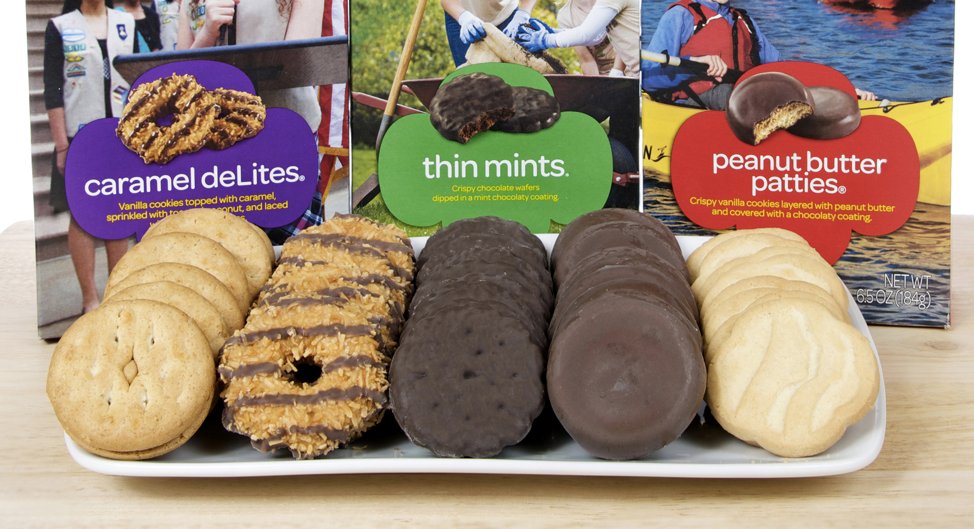Everyone has their favorite cookie, and everyone has their favorite Girl Scout Cookie. Whether you prefer the chocolatey Thin Mints or the crumbly Trefoils, the Girl Scouts have you covered. This season marks the 101st year of cookie sales with no lack of challenges, however a question begs to be asked: how did these treats become so popular?
Let’s first take a look at the history behind the sweets. The first ever Girl Scout cookie sales occurred in December, 1917 by the Mistletoe Troop in Muskogee Oklahoma. Five years later, The Girl Scout magazine The American Girl suggested cookie sales as a possible fundraiser for the organization. At the time, their only product came in the form of a simple sugar cookie.
Despite having to deal with sugar, flour, and butter shortages during World War II, the Girl Scouts baked and sold cookies without a hitch. By the 1950s, the Girl Scouts added three more cookies to their catalogue: “Shortbreads,” “Savannahs” (Peanut Butter Sandwich), and “Thin Mints.” By 1975, the “Samoa” was added.

Girl Scouts selling cookies in 1955
By 1978, the Girl Scouts limited the number of bakers to four to lower prices and uniform, packaging, quality, and distribution. In 1979, the cookies gained more popularity by showcasing their new logo (courtesy of famed graphic designer Saul Bass). By the 1990s, the number of Girl Scout cookie bakers decreased to two: ABC Bakers and Little Brownie Bakers.
In recent years, the organization decided to take a more health-conscious stance. By 2005, the Girl Scouts removed trans fat from their cookies to be healthier and put nutritional information on each box. By 2015, they added the first gluten-free cookies to their product mix: Toffee-tastic (buttery cookies with toffee bits) and Trios (peanut butter, chocolate chips, and whole grain oats).

Percentage of Girl Scout Cookies by Purchase
In economic terms, Girl Scout Cookies are seasonal goods, meaning they are only sold around February each year for around six to eight weeks. The Girl Scouts claim that this is only one facet of their yearly entrepreneurship and leadership program, and that they work on other (less notable) projects throughout each year. Their scarcity gives the cookies a higher rating over other notable cookies like Oreos or Chips Ahoy, giving consumers more of an incentive to purchase Girl Scout cookies in bulk.
Branding is also a huge factor to the Girl Scouts’ success. Since Keebler currently manufactures most of their catalogue, they are able to sell similar cookies (ex: Grasshoppers) year round. However, the average buyer will flock to a name they know rather than generics – especially when that name espouses tastier treats. The very mention of Girl Scout Cookies causes people to perk their ears up like dogs ready for fresh food.
With a dozen varieties of cookies on catalogue, the Girl Scouts show no signs of stopping. What began as a local fundraising event was later refined and standardized over generations into not only a pop culture phenomenon but a nationwide sensation.
Sources:
Gibson, Morgan. “Girl Scouts Release Three New Cookies, Including Two Gluten-Free Flavors.” People Great Ideas, Time Inc., 5 Jan. 2015, greatideas.people.com/2015/01/05/new-girl-scout-cookies-gluten-free/.
“Girl Scout Cookie Statistics.” Statistic Brain, 8 Sept. 2017, www.statisticbrain.com/girl-scout-cookie-statistics/.
Picchi, Aimee. “For the Girl Scouts, Cookies Are More Important than Ever.” CBS News, CBS Interactive, 12 Jan. 2018, www.cbsnews.com/news/for-the-girl-scouts-cookies-are-more-important-than-ever/.
Trierweiler, John. “Girl Scout Cookies Just Got Sweeter in Arizona.” ABC15 Arizona, 20 Feb. 2018, www.abc15.com/news/region-phoenix-metro/central-phoenix/girl-scout-cookies-just-got-sweeter-in-arizona.
Versability. “The Economics of Girl Scout Cookies.” Thought for Your Penny, Brian Penny, 3 Dec. 2017, thoughtforyourpenny.com/money/business/economics-girl-scout-cookies/.

